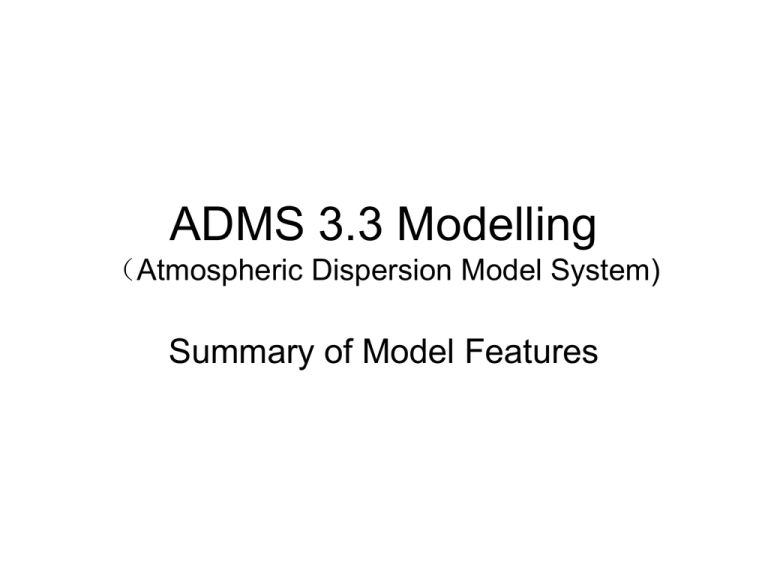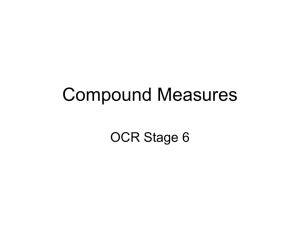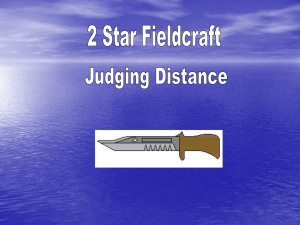
ADMS 3.3 Modelling
(Atmospheric Dispersion Model System)
Summary of Model Features
ADMS 3.3
• Comprehensive models
– “New Generation” Model
– Detailed description of atmosphere based on boundary layer
properties
• Features
–
–
–
–
–
–
–
–
Point, area, line, volume and jet sources
Multiple sources and pollutants
Buildings and Topography
Plume rise
Single condition or statistical meteorology
Odours, radioactivity, plume visibility
Deposition (Wet and Dry)
Statistics, long and short term, percentiles
Factors Influencing Dispersion
– Meteorology
• Wind Speed and direction
• Atmospheric stability (Monin–Obukhov Length and Boundary
Layer Height)
– Release point and conditions
• Elevation (排放高度)
• Velocity
• Temperature
• Ground roughness
– Buildings
• If > 1/3 stack height
– Topography
• If steeper than 1:10 slope
Meteorology
• Older Models
– Passive dispersion model
• Pasquill-Gifford Stability Classes (A – G)
• Wind speed, direction
• ADMS
– Boundary Layer Model
• Boundary layer height
• Monin – Obukhov length
• Wind speed, direction
Meteorological Parameters
• Boundary Layer Height
– Height at which surface effects influence dispersion
– ADMS calculates boundary layer properties for different
heights based on meteorology
• Monin-Obukhov Length
– Measure of height at which mechanical turbulence (机械
湍流) is more significant than convection or stratification
(层流)
– ADMS calculates M-O length based on meteorology and
ground roughness
Meteorology Options
• Specific Data
• Wind speed, wind direction, date, time, latitude(纬
度), boundary layer height, cloud cover
• Met Office Data
• Statistical data (10 years)
– 2200 lines of data (medium run times)
• Hourly sequential data (1 – 5 years)
– Can be used to identify specific conditions for known dates
and times
– 8760 lines of data per year (long run times)
– Use to compare releases against environmental standards
(preferred option (首选) by EA)
Meteorology Effects
• Typical atmospheric conditions within the UK.
• Pasquill - Gifford Stability Classes as modelled in ADMS
• No exact correlation between boundary layer parameters
Stability
Class
Wind Speed
(m/s)
Boundary
Layer Height
(m)
Monin –
Obukhov
Length (m)
A
1
1300
-2
Convective - Hot Still Day
B
2
900
-10
Convective
C
5
850
-100
Convective
D
5
800
∞
E
3
400
100
Stable
F
2
100
20
Stable - Still Night
G
1
100
5
Stable
Conditions
Neutral - Normal UK Day
Example of A – G Conditions
• Stack Release
–
–
–
–
–
SO2,150 g/s
50 m stack
5 m diameter,
20 m/s velocity
15°C
A – G conditions
Centre Line Ground Level Concentrations
A1 Conditions Contour Plot
Convective - Hot Still Day
Stability Class= A; Wind Speed =1m/s; Boundary Layer Height= 1300m;
Monin – Obukhov Length =-2)
SO2 Concentration (ug/m3)
1000
800
600
600
Metres
400
200
500
0
400
-200
300
-400
200
-600
100
-800
-1000
0
200
400
600
800
1000
Metres
1200
1400
1600
1800
2000
D5 Conditions Contour Plot
Neutral - Normal UK Day
Stability Class= D; Wind Speed =5m/s; Boundary Layer Height= 800m;
Monin – Obukhov Length = ∞
SO2 Concentration (ug/m3)
1000
800
600
160
400
140
Metres
200
120
0
100
80
-200
60
-400
40
-600
20
-800
-1000
0
200
400
600
800
1000
Metres
1200
1400
1600
1800
2000
F2 Conditions Contour Plot
Stable - Still Night
Stability Class= F; Wind Speed =2m/s; Boundary Layer Height= 100m;
Monin – Obukhov Length = 20
S02 Concentration (ug/m3)
1000
800
600
10
400
9
Metres
200
8
0
7
6
-200
5
-400
4
-600
3
-800
-1000
0
200
400
600
800
1000
Metres
1200
1400
1600
1800
2000
Buildings
• Can have significant effects
–
–
–
–
–
Entrain (夹卷)pollutants into leeward (下风向)
Increased concentrations close to building
Decreased concentrations further away
Only relevant if building >1/3 stack height
ADMS allows 10 buildings
Building Effects – Tall Stack
• Tall Stack
– Release of NOx from a 50 m
stack (3 m diameter, 5 m/s
velocity, 30°C, 1 g/s NOx)
– Unstable weather conditions
– Stack is at the centre point of
the building
– Building is 30 m high, 30 m
wide, 67 m long
Tall Stack – No Building
NOx Concentration (ug/m3)
400
300
12
11
200
10
Metres
100
9
8
0
7
6
-100
5
-200
4
3
-300
2
-400
0
100
200
300
400
500
Metres
600
700
800
900
1000
Tall Stack – With Building
NOx Concentration (ug/m3)
400
300
10
200
9
Metres
100
8
0
7
6
-100
5
-200
4
-300
2
-400
0
100
200
300
400
500
Metres
600
700
800
900
1000
Building Effects – Short Stack
• Short Stack
– Release of NOx from a 35 m
stack (3 m diameter, 5 m/s
velocity, 30°C, 1 g/s NOx)
– Unstable weather conditions
– Stack is at the centre point of
the building
– Building is 30 m high, 30 m
wide, 67 m long
Short Stack - Without Building
NOx Concentration (ug/m3)
400
24
23
22
21
20
19
18
17
16
15
14
13
12
11
10
9
8
7
6
5
4
3
2
300
200
Metres
100
0
-100
-200
-300
-400
0
100
200
300
400
500
Metres
600
700
800
900
1000
Short Stack - With Building
NOx Concentration (ug/m3)
400
24
23
22
21
20
19
18
17
16
15
14
13
12
11
10
9
8
7
6
5
4
3
2
300
200
Metres
100
0
-100
-200
-300
-400
0
100
200
300
400
500
Metres
600
700
800
900
1000
Topography
• Can effect dispersion
–
–
–
–
Changes plume trajectory
May increase or decrease concentrations
Include if terrain exceeds 1:10 (maximum 1:3)
Terrain data available
Topography Example
–
–
–
–
–
–
Release of NOx from a 65 m stack
5 m diameter
5.25 m3/s flowrate
69°C,
1 kg/s NOx
Neutral weather conditions
• 10 m/s wind
• Boundary layer 1000 m
– Simple hill 2.6 km to the East and 1 km South of the
release
Without Hill
NOx Concentration (ug/m3)
4000
3000
1600
1500
1400
2000
1300
1200
Metres
1100
1000
1000
900
800
700
0
600
500
400
-1000
300
200
-2000
-2000
-1000
0
1000
Metres
2000
3000
4000
With Hill
NOx Concentration (ug/m3)
4000
3000
1600
1500
1400
2000
1300
1200
Metres
1100
1000
1000
900
800
700
0
600
500
400
-1000
300
200
-2000
-2000
-1000
0
1000
Metres
2000
3000
4000
3D Hill
Statistical Meteorology
• 10 years statistical data
• 1 – 5 years hourly sequential data
• Can calculate
– Annual averages
– Percentiles (百分位数) (worst case conditions)
– No of exceedences/year (年超标数)
– Areas affected (影响区域)
• Direct comparison with NAAQS (Legislation)
Statistical Results
Long Term SO2 Concentration
376000
375800
1.6
375600
1.5
375400
1.4
1.3
Metres
375200
1.2
1.1
375000
1
374800
0.9
0.8
374600
0.7
0.6
374400
374200
442000 442200 442400 442600 442800 443000 443200 443400 443600 443800
Metres
Statistical + Topography
Reproduced from Ordnance
Survey® Panorama Digital Data,
by permission of Ordnance
Survey® on behalf of the
Controller of Her Majesty’s
Stationary Office. © Copyright
1990. All rights reserved. Licence
No. 100040193
Digital Maps
• Available from Ordnance Survey (UK)
• 1:50000 or 1:10000
• Can overlay (覆盖)release contours onto
maps
Digital Map Example
Reproduced from
Ordnance Survey® 1:10K
Raster Data, by permission
of Ordnance Survey® on
behalf of the Controller of
Her Majesty’s Stationary
Office. © Copyright 1990.
All rights reserved. Licence
No. 100040193
Digital Map + Topography + Concentrations
Reproduced from
Ordnance Survey®
Panorama Digital Data
and1:10K Raster Data, by
permission of Ordnance
Survey® on behalf of the
Controller of Her Majesty’s
Stationary Office. ©
Copyright 1990. All rights
reserved. Licence No.
100040193
Odours (气味)
• Model as Odour Units
– ou: Number of times the mixture must be diluted at STP
(Place) to reach detection limit of 1 ou.
– ouE: The mass of pollutant that when evaporated into 1 m3
of gas at STP is 1 ou
– Information on detection limit is required.
• ADMS
– Input and output in terms of ou or ouE.
Odour Example
• Release from landfill site
– Odours in ouE
– Two area sources, one line source
• Landfill 1: 100 m x 100 m, 10 ouE/m2/s
• Landfill 2: 100 m x 100 m, 5 ouE/m2/s
• Line 1: 200 m, 2 ouE/m/s
– Flat terrain (平原地形), no buildings
– Neutral conditions
• 10 m/s wind
• Boundary layer 1000 m
– Short term hourly average concentration
Odour Example - Sources
Landfill Site
600
400
200
0
-200
LANDFILL1
LINE1
LANDFILL2
-400
-600
Output grid
Area/line/volume source
0
200
400
600
800
1000
1200
1400
Odour Example - Results
Landfill Odour Release (ouE)
600
100
95
90
85
80
75
70
65
60
55
50
45
40
35
30
25
20
15
10
5
1
400
Metres
200
0
-200
-400
-600
0
200
400
600
Metres
800
1000
1200
1400
Time Varying Releases (时变源)
• Release rates often vary with production
• Time varying releases
– Hourly sequential meteorological data
– Details of release for each hour of meteorological data
• flow, temperature, concentration, velocity
• Results can differ considerably when compared to
average releases
Fluctuations
• Meteorology usually stable over 1 hour
• Turbulence causes short duration fluctuations
• Interest in lower times for exposure
– Odours
– NAQS (UK)(SO2, 15 minute mean)
• ADMS turbulence calculations
– Percentiles
– Probability distribution function
– Toxic response (毒性反应)
Other Features
•
•
•
•
•
•
Variable surface roughness
Treatment of land sea internal boundary layer
Puffs
NOx Chemistry
Radioactive decay
Plume visibility (condensed plume)
AERMOD model
• AERMOD- AMS/EPA Regulatory Model
• AERMOD was introduced by the US EPA as a
Replacement for (取代) Industrial Source Complex (ISC) model
for estimating the air quality impact of sources for source–
receptor distances of kilometers.
• AERMOD is designed to use vertical profiles of wind speed and
turbulence measured at the site where the model is applied.
AERMOD model
AERMOD can accept the following turbulence
measurements:
•
standard deviation of the horizontal wind
component, sy, and standard deviation of the vertical
wind component, sw. There are future plans to include
other turbulence parameters. Such meteorological
observations are usually not available at most sites of
interest, and insisting on site-specific measurements is
not practical.
AERMOD model
• Thus, AERMOD uses a processor (处理模块) to
construct inputs from routinely available
National Weather Service (NWS) surface and upper
air data from nearby locations.
Meandering (扩散) in AERMOD
• AERMOD accounts for meandering by defining the horizontal
concentration distribution, H(x,y), as a linear combination of Gaussian and
uniform distributions:
•
•
where the plume distribution is
and the uniform distribution is given by
where r is the source–receptor distance. The weighting factor, fp, is taken as
the square of the ratio of the mean vector wind speed, U, to the scalar
transport wind, Ueff:
Meandering in AERMOD
• For a source at height hs, the vertical concentration distribution, S(z), is
• where the vertical plume spread is given by the linear expression
Meandering in AERMOD
where the random components u and v are chosen from a normal
distribution with a zero mean and a standard deviation of :
FROM : A. Venkatram et al. / Atmospheric Environment 38 (2004) 4633–4641;
V. Isakov et al. / Atmospheric Environment 41 (2007) 1689–1705
•
•
•
•
•
•
•
•
•
•
大气新导则会议(2009-3-6)
陕西环境保护局
王厅长讲话
4月1日执行新导则(报告书,审批)
徐大海
Screen 3a model
screen3A.exe (dos版)极端情况
确定评价等级
Aermod model
平坦地形,no2, 输入o3浓度
• 地形,源点,极坐标(r,角)
• DOS 版,需探空资料,没探空,用地面资料形成;稳态
的烟流模式;
• 高空(无),计算地面浓度较低;
• 第三代模式;静态模式,老导则的后代产品;探空资料问
题?2倍误差
• Calpuf模式
• 完整;考虑地形;50km;复杂流畅;下地面不均匀;
Calmet 边界层气象模式;mm5资料(中尺度模式);下
地面类型;KSP颗粒模式;光化学模式;能见度模式;流
场模式;CALPOST后处理模式
• 空气质量模式(calpuff,calpost);








